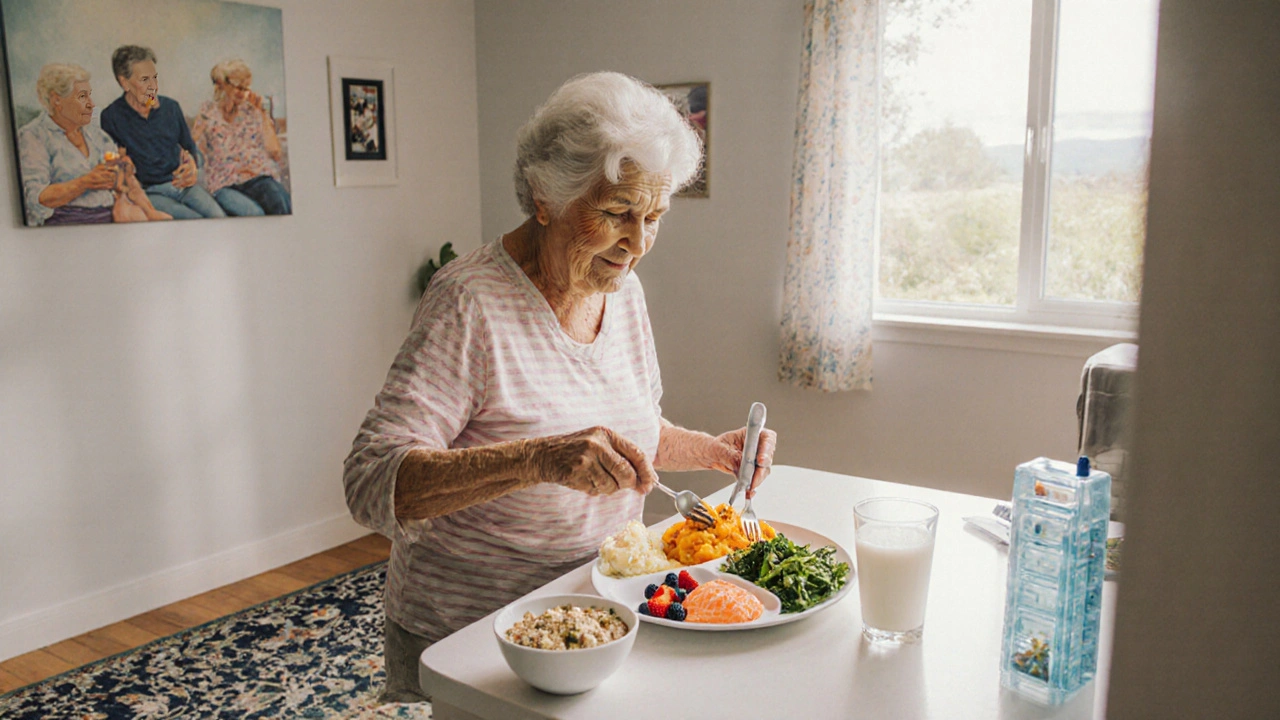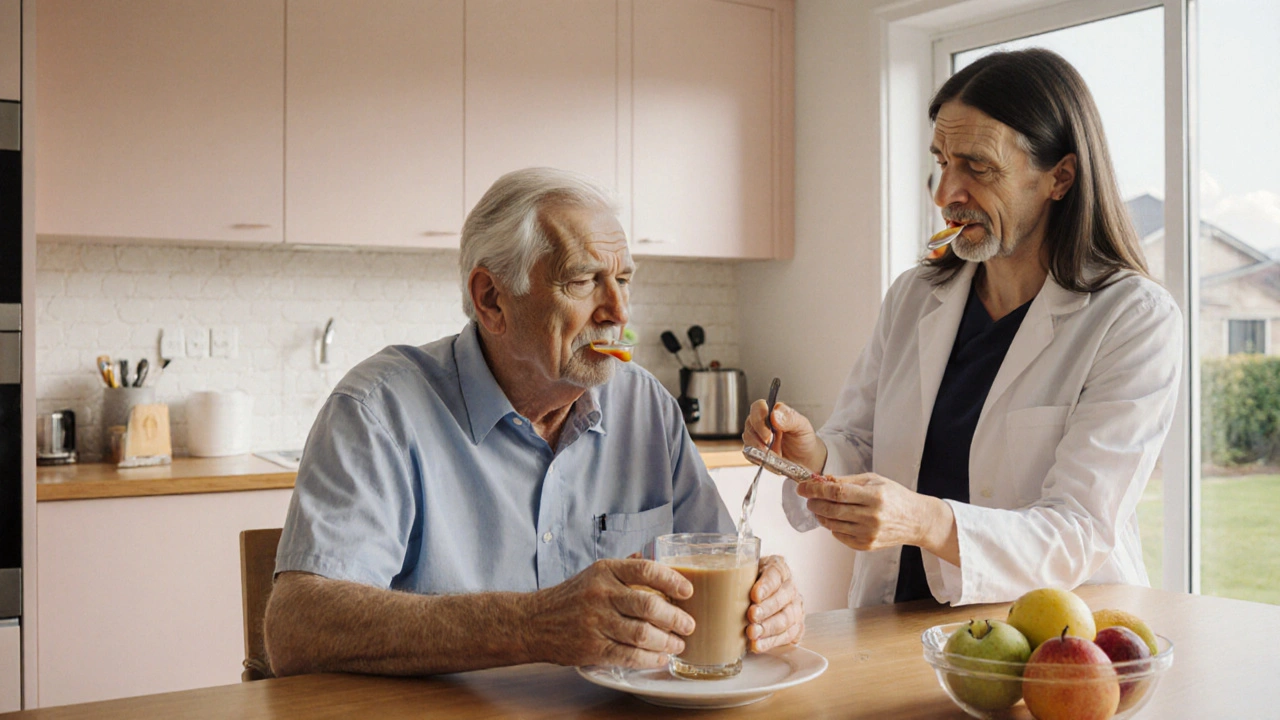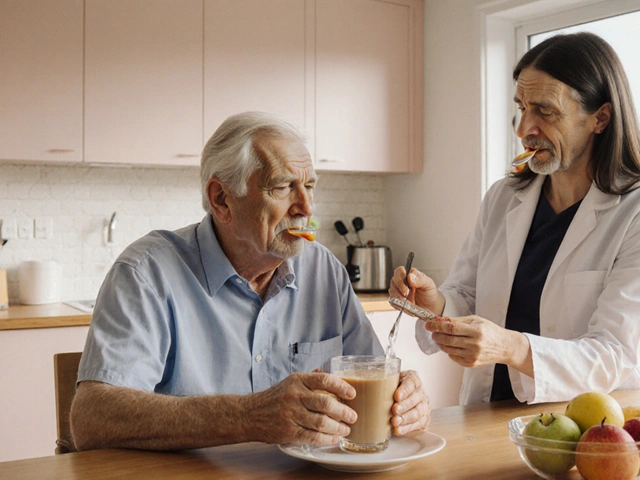Parkinson's disease is a progressive neurodegenerative disorder that primarily impairs motor control, but it also interferes with essential daily functions like swallowing and eating. Most patients notice subtle changes in the first few years-food may feel like it "stucks" or coughing after a sip becomes common. When those signs are ignored, the chain reaction can lead to malnutrition, weight loss, and even life‑threatening complications.
Why Swallowing Changes in Parkinson's
Swallowing, or dysphagia, is a coordinated effort involving the brainstem, cranial nerves, and muscles of the mouth, throat, and esophagus. Parkinson's disease damages dopaminergic neurons that fine‑tune these movements, resulting in three main problems:
- Oral motor dysfunction: reduced tongue strength and slower chewing.
- Impaired pharyngeal contraction: the throat muscles don’t close tightly, letting food slip toward the airway.
- Delayed esophageal clearance: food stays longer in the esophagus, increasing reflux risk.
These deficits appear gradually, often before a formal diagnosis of dysphagia is made.
How Dysphagia Manifests Day‑to‑Day
Older adults with Parkinson's frequently report the following signs:
- Drooling or excessive saliva (a sign of reduced swallowing frequency).
- Food residue in the mouth after a bite.
- Wet or gurgling voice after meals.
- Coughing or choking during or after eating.
- Unexplained weight loss despite adequate calorie intake.
When these symptoms persist, the risk of aspiration pneumonia climbs sharply. Studies from the National Institute of Neurological Disorders and Stroke show that up to 40% of Parkinson's patients develop pneumonia as a direct result of silent aspiration.
Health Risks Beyond the Lungs
Beyond pneumonia, compromised swallowing undermines nutritional status. Low protein intake speeds muscle wasting, worsening gait and balance. Malnutrition also impairs immune function, making infections more likely. Gastroesophageal reflux disease (GERD) often co‑exists, because a weakened lower esophageal sphincter can’t keep stomach acid out, irritating the throat and further aggravating dysphagia.
Therapeutic Approaches That Really Work
Early identification and targeted therapy are the cornerstones of care. A qualified speech‑language pathologist (SLP) can assess swallowing safety using a bedside exam and, when needed, a video fluoroscopic swallow study (VFSS). Based on the findings, the SLP designs a personalized swallowing therapy plan that may include:
- Oral motor exercises to boost tongue strength.
- Postural adjustments-like chin‑tuck or head‑turn-to redirect the bolus.
- Texture modification: pureed foods or thickened liquids reduce the chance of aspiration.
- Pacing techniques: encouraging smaller bites and longer rests between swallows.
These interventions can improve airway protection in up to 60% of patients within three months.

Medication vs. Surgical Options for Swallowing
While therapy addresses the mechanics, medications target the underlying dopaminergic deficit. Levodopa therapy remains the first‑line drug for motor symptoms, and many patients notice modest swallowing improvements within weeks. However, levodopa’s effect can wear off, leading to "off‑period" dysphagia.
For those with advanced disease, deep brain stimulation (DBS) offers an alternative. DBS can smooth out motor fluctuations, but its impact on swallowing is mixed-some studies report benefit, others note no change.
| Attribute | Levodopa Therapy | Deep Brain Stimulation |
|---|---|---|
| Mechanism | Dopamine precursor that replenishes striatal dopamine | Electrical pulses modulate basal ganglia activity |
| Onset of Effect | Minutes to hours | Weeks to months (post‑surgery programming) |
| Impact on Dysphagia | Modest improvement in 50‑60% of patients during "on" periods | Variable; some report reduced choking, others no change |
| Typical Side Effects | Nausea, orthostatic hypotension, dyskinesia | Device infection, hardware malfunction, mood changes |
Choosing between the two depends on disease stage, overall health, and personal goals. A multidisciplinary team-neurologist, SLP, dietitian, and surgeon-should weigh the pros and cons.
Nutrition Strategies to Keep Energy Up
Even with therapy, patients often need to adapt their diet. Here are evidence‑based tips:
- High‑calorie, nutrient‑dense foods: add nut butter, avocado, or whey protein powders to meals.
- Separate liquids from solids: sip water between bites to clear the palate and reduce choking.
- Small, frequent meals: five to six mini‑meals keep energy stable and reduce fatigue.
- Use thickening agents: commercial products can raise liquid viscosity to level2 (nectar‑like) or level3 (honey‑like) as recommended by the International Dysphagia Diet Standardisation Initiative.
- Monitor weight weekly: any loss >5% of body weight warrants dietitian referral.
Supplemental oral nutrition shakes can fill gaps, but they should complement-not replace-regular meals.
When to Seek Professional Help
Any of the following signs signal that a formal assessment is overdue:
- Repeated coughing or choking episodes.
- Persistent sore throat or hoarseness after meals.
- Weight loss greater than 2% per month.
- Frequent respiratory infections.
- Difficulty managing oral medications due to swallowing problems.
Prompt referral to a neurologist and an SLP can prevent complications and preserve independence.
Related Concepts and Next Steps
Understanding the ripple effects of swallowing problems opens doors to broader health topics. For example, exploring Parkinson's gait disturbances reveals how balance training can indirectly improve eating posture. Delving into cognitive decline in Parkinson's shows why medication timing matters for safe meals. Readers interested in the gut‑brain connection may also investigate microbiome changes in neurodegeneration.
Future articles could cover:
- “Managing Medication Timing to Reduce Dysphagia”
- “The Role of Caregiver Training in Safe Feeding Practices”
- “Emerging Wearable Sensors for Early Detection of Swallowing Impairments”

Frequently Asked Questions
What early signs indicate swallowing trouble in Parkinson's?
Look for drooling, a sensation of food sticking in the mouth, frequent coughing during meals, and unexplained weight loss. Even subtle changes, like a wet voice after drinking, merit a screening.
Can levodopa fully fix dysphagia?
Levodopa helps many patients, but its effect is usually modest and limited to the "on" phase. It rarely eliminates the problem, so therapy and diet adjustments remain essential.
Is deep brain stimulation safe for the throat?
DBS does not directly affect the muscles of swallowing. However, by smoothing motor swings, it can indirectly help. Risks are related to the surgery itself-infection, hardware issues-not to swallowing.
How often should a Parkinson's patient see a speech‑language pathologist?
Initial evaluation is ideal once dysphagia is suspected. Follow‑up appointments every 3-6months allow the team to adjust exercises, track weight, and prevent complications.
What dietary changes are most effective?
High‑calorie, soft‑texture foods, thickened liquids, and small frequent meals are key. Adding protein‑rich additives (e.g., Greek yogurt, whey powder) helps maintain muscle mass.





Post A Comment